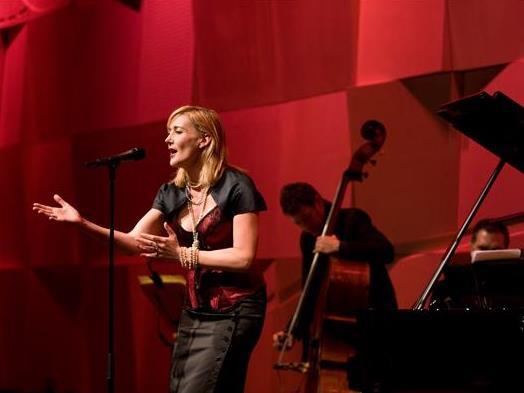Melbourne Recital Centre- Etihad 2013 Creative Partnership winners. Image via Creative Partnerships
Business loves innovation and business loves new markets. We are now living in an age of individual choice, the engine driving market forces. As a result, businesses are reinventing themselves all the time to keep ahead of the increasing fragmentation. This is what an arts organisations can potentially offer any business.
In an age when businesses are looking for a competitive edge and for innovative ways to connect with the arts that go beyond classic sponsorship, creativity can bring them together. But it means comparing what they want out of the partnership to the mission of the business. What the arts organisation offers has to be relevant to the business. That means cultivating a mutually beneficial arrangement in which the business can see the value that moves its own interests and strategic goals forward.
Michael Tortoni, the artistic director of the Melbourne International Jazz Festival and a former MIJF chairman, says business look for some link to creativity through their association with the arts.
Tortoni set up Australia’s leading jazz club Bennetts Lane while he was working as a stockbroker. The creativity of the music helped him with the business. ‘In business, everything is so reactive and music used to give me the chance to reflect on things unconsciously.’
He said businesses looking to partner with the MIJF would be looking for the opportunity to expose their clients to a different medium, and create networking opportunities.
‘Music is an attractive pursuit so I would want to take my clients to certain events to give them a different experience from business,’ Tortoni said.
He says the arts provides good sponsorship opportunities. ‘Generally they want an outward looking partnership. They generally want their name out there if they are supporting the arts.”
Fiona Menzies, the chief executive of Creative Partnerships Australia, said a business considering an arts partnership would look carefully at the arts organisation’s market. Does that market have any bearing on the business? Does the business have a similar market? Does the arts organisation’s following open up a new market for the business?
‘The key one is demographics because businesses are always trying to sell a product or a service,’ Menzies said. ‘Therefore they will enter into partnerships or sponsorships with organisations that have the demographics that they’re targeting. And that can be quite broad or it can be quite narrow.
‘“These days, businesses are looking for opportunities for sales.’That means any partnership with the arts organisation, even a sponsorship, must have a business purpose. Corporations are not in the business of charity.
‘A sponsorship isn’t philanthropic,’ she said. ‘It’s a business transaction. Therefore they are looking at ways that can increase their sales and so firstly they have to make sure they are finding the right demographic for their product or service and that it will be done in a way to attract.’
There could be many examples of that. An airline may say may offer the arts organisation’s subscribers a special deal on air fares. But at the same time, that airline will be tracking very carefully where sales of that special deal are coming from. How many are buying it? What are their other buying preferences? If there isn’t the right fit, they might rethink that offer. For the airline, the bottom line is that it’s a business and any special deal is all about getting more business.
Etihad Airlines for instance would have done a complete due diligence on the Melbourne Recital Centre. It would have seen that its clients are well to do, have a higher level of income than most others and would be more inclined to travel overseas.
Menzies says the conservative nature of the Melbourne Recital Centre clientele would have been critical for Etihad Airlines.
‘“They would want to be associated with organisations that are very reputable. If you are an airline you are less likely to want to associate yourself with a more risk raking arts organisation. So the Melbourne Recital Centre would be considered to be reasonably conservative.‘On the other hand, a particular brand of automotive firm might say we want to look funky, so they would want an arts organisation with a similar sort of reputation.’ Being principal partner for Melbourne Now, allowed luxury car company Mercedes Benz to project a more adventurous image.
Karen Mahlab, who runs ProBono Australia, said the key question any business would ask the arts organisation would be around the kind of clientele it’s attracting. But they would also be looking carefully at whether the arts organisation has any business credentials.
‘They would want to know who their market is. They would also want to know what their strategy is moving forward. They would want to know if the arts organisation is going to be around in 12 months’ time. They would want to know about all about their financial robustness.’
‘And they would want to know what their reputation is in the market place and they would want to know all about their leadership team.’
Mahlab said any partnership would have to be carefully managed.
‘The best business community partnerships are ones that are nuanced and have been around for a long time and benefitting both sides.’
The arts organisation would sometimes have to be prepared to accept people from the business as board members.
And she said both sides would have to ask serious questions about how the arrangement would go down with the general public, and look at the impact on both sides of the fence.
‘Corporates have to start thinking about what they are doing in the community and they have to be prepared not only for backlashes against their own activity but also for their partners’ activities. And that is happening more and more.
‘The arts organisations might be asked why they partnered with an organisation that was doing something questionable in the eyes of the market or their customers or clients.’





